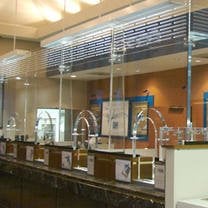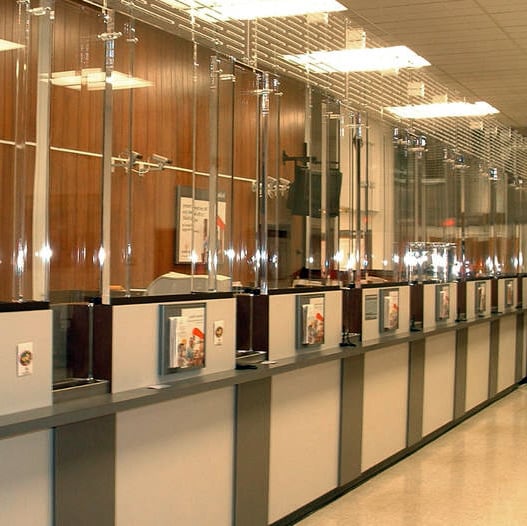There are three basic bullet resistant barrier configurations. We spoke about Fixed Barriers in a previous blog. Fixed barriers are ideal for spaces that have individual areas of security needs. When you have a larger, multi-use area like a teller line that needs protection, a Fixed Barrier becomes inefficient, aesthetically displeasing, and not cost-effective. In these situations, Freestanding Barriers make the most sense.
Understanding the Freestanding Barrier System

Arch Window System installed at a national bank
Two of the most common industries where you will see a Freestanding Barrier in place is financial and municipal. When you have multiple consecutive stations that need protection like in a bank or municipal transaction lane, the freestanding option is more aesthetically pleasing because you won’t need to install bullet resistant frames around every individual transaction window. Instead, the system is designed to be seamless across the entire teller line area. Other necessary components for a freestanding system include ballistic doors, bullet resistant paneling, and bullet resistant fiberglass. Which additional elements are needed depend on the complete scope of the job (new construction vs. retrofit).
You don’t need to incorporate bulletproof glass all the way to the building’s ceiling though. That would add unnecessary costs to your project that won’t equate to increased protection. Instead, you can incorporate a Louver system when you get closer to the ceiling and still offer a seamless look. Louvers also allow for natural airflow and increased voice transmission.
Clear bullet resistant acrylic doors and windows can also be combined with bullet resistant counters and other millwork to blend in with existing decor, giving the interior of the building a more clean and clear look.
4 Freestanding Barrier Configurations
There are four main configurations for bullet resistant barrier systems. Each of them is safe, secure, functional, and aesthetically pleasing. Which system you decide to go with depends on the layout of the area that needs protection, as well as personal design preferences.
Baffle Window System
Baffle Window Systems are the oldest configurations for bullet resistant barriers. Utilizing staggered pieces of bullet resistant glass, this system provides completely unobstructed views and provides maximum voice transmission. This configuration offers an unobstructed view for the teller and security cameras.
Arch Window System
The Arch Window System is the most commonly used bullet resistant barrier and features an arch configuration providing natural voice transmission. Arch Windows provide an aesthetically pleasing and approachable design to allow for safe and natural interactions between employees and their customers.
Secure Sound Window System
Secure Sound Systems are a newer innovation in bullet resistant security. They provide a friendly and unobtrusive access portal for employee/customer interactions. Because of this, Secure Sound Systems are typically more appealing architecturally.
Speak Hole and Backer System
Speak Hole and Backer Systems integrate a speaker hole and backing plate into the bullet resistant transaction window. This bulletproof barrier system provides convenient access for employee/customer transactions within a bank teller line.
Choosing the Correct Glass
The most common bulletproof glass protection level for banks and financial institutions is Level 1, but in specific circumstances where threat level perception is higher, we use Level 3 glass. Level 2 bulletproof glass used to be a popular option for banks, but it has fallen out of favor. Instead, project planners who want to have more protection skip Level 2 and go right to the next level.
Because of the edge polishing and custom cuts needed for Freestanding Barriers, it’s recommended to use bulletproof Acrylic or Polycarbonate for your design. Glass Clad Polycarbonate is best used in exterior applications. Using it for a freestanding barrier would incur additional costs for the finishes required with each barrier
Next Steps
-
Read more about Freestanding Barrier Systems
-
Download our Ultimate Architect Resources Kit


